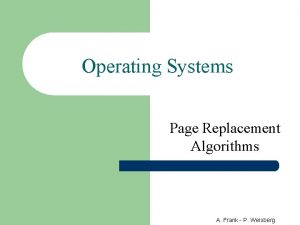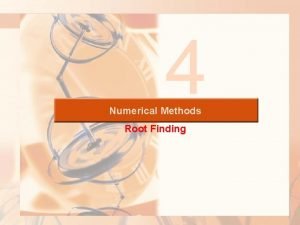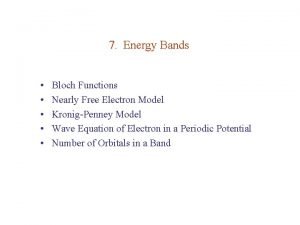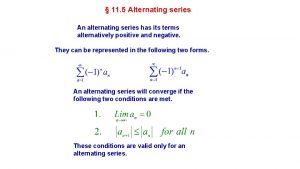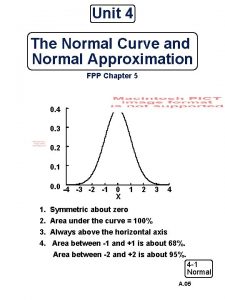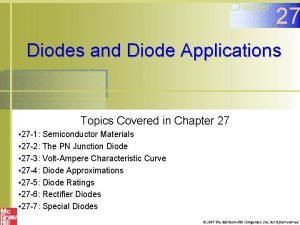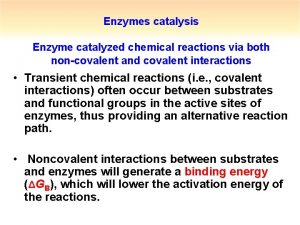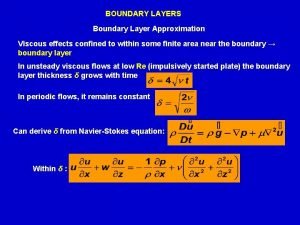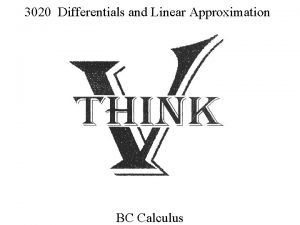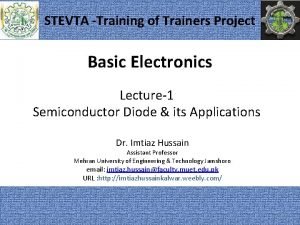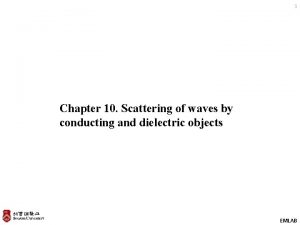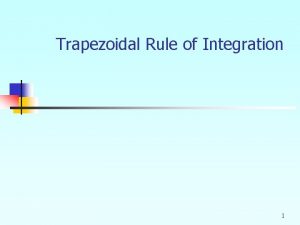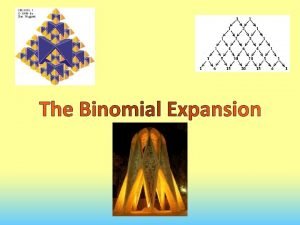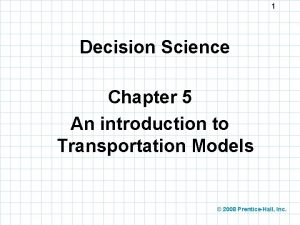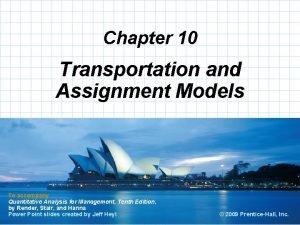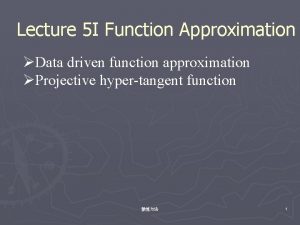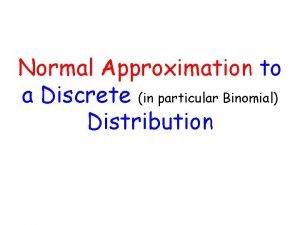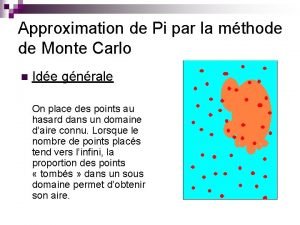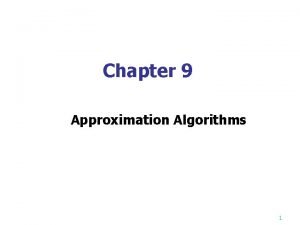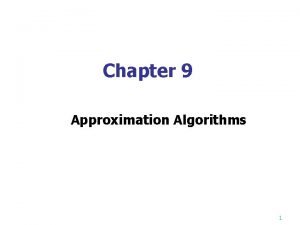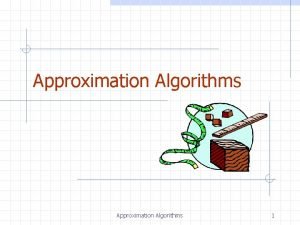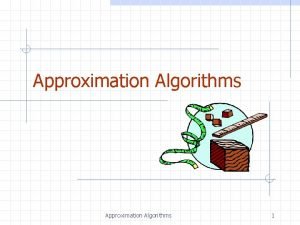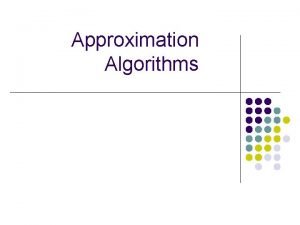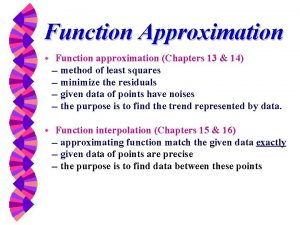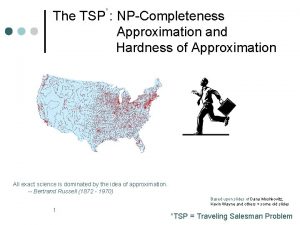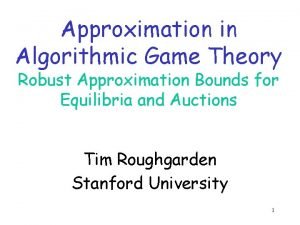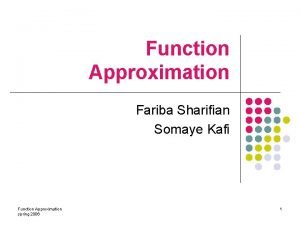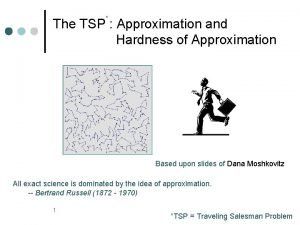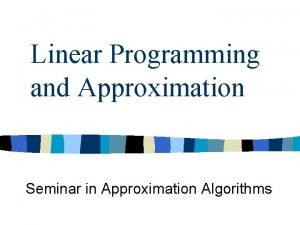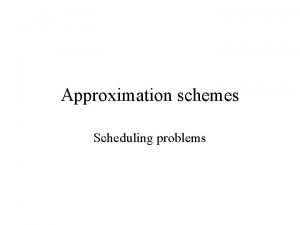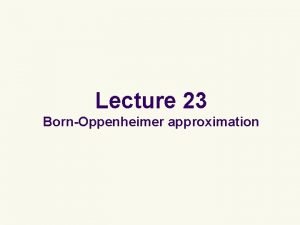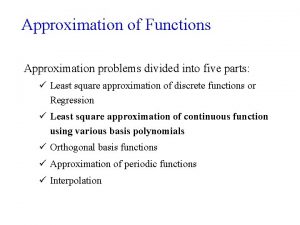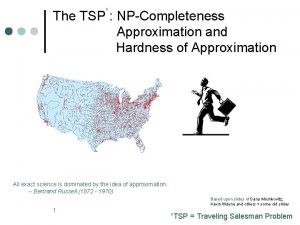Approximation Algorithm Updated on 20121225 1 Approximation Algorithm



































- Slides: 35

Approximation Algorithm Updated on 2012/12/25 1

Approximation Algorithm n n Up to now, the best algorithm for solving an NP-complete problem requires exponential time in the worst case. It is too timeconsuming. To reduce the time required for solving a problem, we can relax the problem, and obtain a feasible solution “close” to an optimal solution 2

Approximation Algorithm n n One compromise is to use heuristic solutions. The word “heuristic” may be interpreted as “educated guess. ” 3

Approximation Algorithm 4

Approximation ratio bound 5

-approximation algorithm n n An approximation algorithm with an approximation ratio bound of is called a -approximation algorithm or a (1+ )approximation algorithm. Note that is always larger than 1 and = -1. 6

Vertex Cover Problem n n Let G=(V, E). The subset S of V that meets every edge of E is called the vertex cover. The Vertex Cover problem is to find a vertex cover of the minimum size. It is NP-hard or the optimization version of an NP-Complete decision problem. 7

Examples of vertex cover 8

9

10

C*: optimal solution C: approximate solution A: the set of edges selected in step 4 When one edge is selected, 2 vertices are added into C. No two edges in A share a common endpoint due to step 6. 11

Bin Packing Problem n n Given n items of sizes a 1, a 2, …, an, 0 ai 1 for 1 i n, which have to be placed in bins of unit capability, the bin packing problem is to determine the minimum number of bins to accommodate all items. If we regard the items of different sizes to be the lengths of time of executing different jobs on a standard processor, the problem becomes to use minimum number of processors which can finish all of the jobs within a fixed time. //You can assume the longest job takes one unit time, which equals to the fixed time. 12

Example of Bin Packing Problem n E. g. Given n = 5 items with sizes 0. 3, 0. 5, 0. 8, 0. 2 0. 4, the optimal solution is 3 bins. The bin packing problem is NP-hard. 13

An approximation algorithm for the bin packing problem n n n An approximation algorithm: (first-fit) place item i into the lowest-indexed bin which can accommodate it. OPT: the number of bins of the optimal solution FF: the number of bins in the first-fit algorithm C(Bi): the sum of the sizes of items packed in bin Bi in the first-fit algorithm Let FF=m. 14

An approximation algorithm for the bin packing problem n n OPT , ceiling of sum of sizes of all items C(Bi): the sum of sizes of items packed in bin Bi C(Bi) + C(Bi+1) 1 (a)(Otherwise, the items in Bi+1 will be put in Bi. ) C(B 1) + C(Bm) 1 (b)(Otherwise, the items in Bm will be put in B 1. ) For m nonempty bins, C(B 1)+C(B 2)+…+C(Bm) m/2, (a)+(b)for i=1, . . , m FF = m < 2 = 2 2 OPT FF < 2 OPT 15

16

17

18

19

An approximation algorithm for Euclidean traveling salesperson problem (ETSP) n n The ETSP is to find a shortest closed path through a set S of n points in the plane. The ETSP is NP-hard. 20

Approximation Algorithm for ETSP n n n Input: A set S of n points in the plane. Output: An approximate traveling salesperson tour of S. Step 1: Find a minimum spanning tree T of S. Step 2: Find a minimum Euclidean weighted matching M on the set of vertices of odd degrees in T. Let G=M∪T. Step 3: Find an Eulerian cycle of G and then traverse it to find a Hamiltonian cycle as an approximate tour of ETSP by bypassing all previously visited vertices. 21

Eulerian Cycle n n An Eulerian path (Eulerian trail, Euler walk) in a graph is a path that uses each edge precisely once. If such a path exists, the graph is called traversable. An Eulerian cycle (Eulerian circuit, Euler tour) in a graph is a cycle with uses each edge precisely once. If such a cycle exists, the graph is called Eulerian. 22

n n L. Euler showed that an Eulerian cycle exists if and only if all vertices in the graph are of even degree and all edges are contained in the same component. L. Euler also showed an Eulerian path exists, if and only if at most two vertices in the graph are of odd degree and all edges are contained in the same component. 23

n n Leonhard Euler (April 15, 1707 - September 18, 1783) (pronounced "oiler") was a Swiss mathematician and physicist. He is considered (together with Gauss) to be the greatest mathematician ever. Leonhard Euler stated and solved the problem of Seven Bridges of Königsberg in 1736, which is the first formally discussed problem in graph theory. 24

Eulerian Cycle exists because degree(V 1) = 4 degree(V 2) = 2 degree(V 3) = 4 degree(V 4) = 4. 25

This is the Eulerian Cycle. 26

n n A Hamiltonian path (also called traceable path) is a path that visits each vertex exactly once. A Hamiltonian cycle (also called Hamiltonian circuit, vertex tour or graph cycle) is a cycle that visits each vertex exactly once, except for the starting vertex. 27

Minimum Euclidean Weighted Matching (MEWM) Problem n Given a set of points in the plane, the minimum Euclidean weighted matching problem is to join the points in pairs by line segments such that the total length is minimum. 28

Approximation Algorithm for ETSP n E. g. Step 1: 29

Approximation Algorithm for ETSP n Step 2: The number of points with odd degrees must be even. , which One edge contributes 2 degrees is even 30

Approximation Algorithm for ETSP n Step 3: P 3 and P 4 are visited twice. By bypassing P 3 and P 4 and connecting P 6 to P 1 directly, we obtain a Hamiltonian cycle. 31

Approximation Algorithm for ETSP n n Time complexity: O(n 3) Step 1: O(n log n) Step 2: O(n 3) Step 3: O(n) How close the approximate solution to an optimal solution? 32

How good is the solution ? The approximate tour is within 3/2 of the optimal one. n Reasoning: L: optimal ETSP tour, T: MST, Lp: a path derived by removing one edge from L (Lp is also a spanning tree) length(T) length(Lp) length(L) n Let Lp=j 1…i 1 j 2…i 2 j 3…i 2 m, where {i 1, i 2, …, i 2 m} is the set of odd-degree vertices in T where indices of vertices in the set are arranged in the same order as they are in the optimal ETSP tour L. n 33

How good is the solution ? Let M be the minimum Euclidean weighted matching (MEWM). Consider the two matchings: M 1={[i 1, i 2], [i 3, i 4], …, [i 2 m-1, i 2 m]} and M 2={[i 2, i 3], [i 4, i 5], …, [i 2 m, i 1]}. We have (by triangular inequality) length(L) length(M 1) + length(M 2) 2 length(M ) length(M) 1/2 length(L ) G = T∪M length(T) + length(M) length(L) + 1/2 length(L) = 3/2 length(L) 34

Q&A 35
 Deped mission and vision
Deped mission and vision The symbol tsfa in alu operations include
The symbol tsfa in alu operations include Lru approximation algorithm
Lru approximation algorithm Birge-vieta method uses formula of
Birge-vieta method uses formula of Nearly free electron theory
Nearly free electron theory Steady state kinetics
Steady state kinetics Weddle's rule
Weddle's rule Approximation algorithms for np-hard problems
Approximation algorithms for np-hard problems Alternating series
Alternating series Normal curve approximation
Normal curve approximation First approximation of diode
First approximation of diode Tanh approximation
Tanh approximation Muscle approximation
Muscle approximation Interpolation vs approximation
Interpolation vs approximation Catalysis by approximation
Catalysis by approximation First born approximation
First born approximation What does approximation mean
What does approximation mean Displacement thickness
Displacement thickness Remnote updates
Remnote updates Diode approximation
Diode approximation Born oppenheimer approximation
Born oppenheimer approximation Use approximation to check your answer
Use approximation to check your answer Virtual number of teeth in bevel gear
Virtual number of teeth in bevel gear Euler's approximation
Euler's approximation Born approximation
Born approximation Single segment trapezoidal rule
Single segment trapezoidal rule Binomial expansion of partial fractions
Binomial expansion of partial fractions Vam stands for vogels approximation ___________________.
Vam stands for vogels approximation ___________________. Diophantine approximation
Diophantine approximation Stepping stone method
Stepping stone method Tanh approximation
Tanh approximation Lippmann schwinger equation born approximation
Lippmann schwinger equation born approximation Blt method will convert analog filter to dt filter that has
Blt method will convert analog filter to dt filter that has Normal approximation to binomial calculator
Normal approximation to binomial calculator Approximation de pi
Approximation de pi Contralateral slrt
Contralateral slrt


